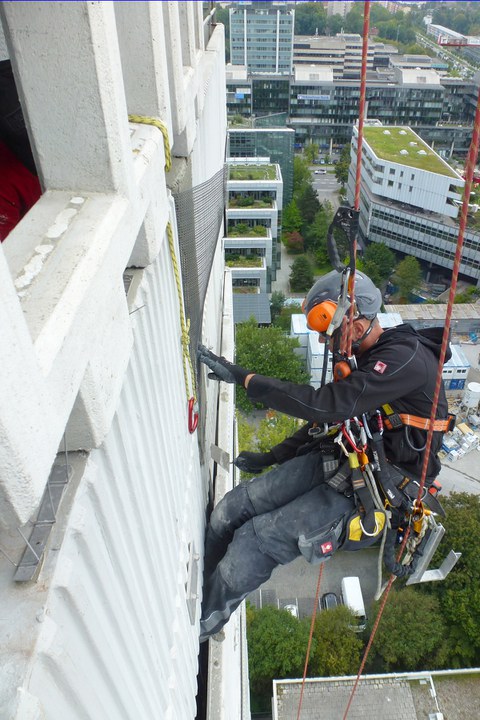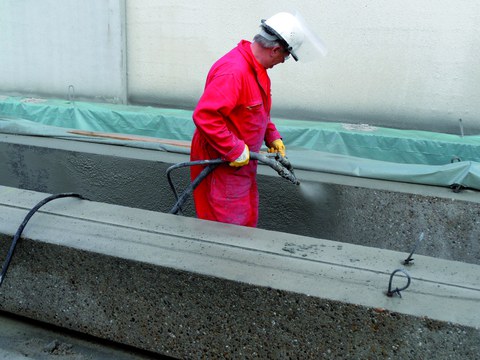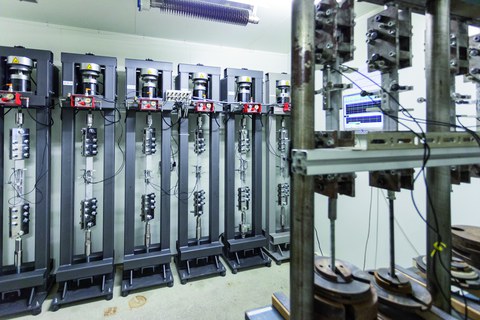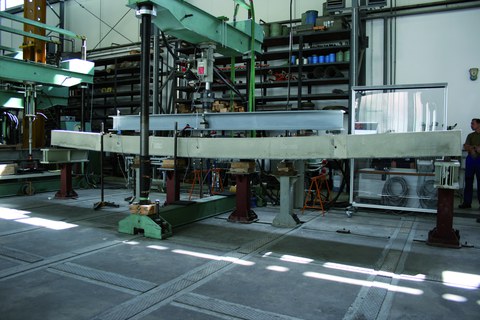Supplementary tests to abZ Z-31.10-182 (TUDALIT®)
Table of contents
Project data
|
Titel | Title |
Report in the year book 2015
Successfully applied – TRC is taking off!

Repairing of a damaged façade element
In 2014, the German Centre of Competence for Construction (DIBt) granted the approval Z-31.10-182 to the German Centre of TRC (DZT) on the basis of many test series. Basically, this approval defines the application of textile reinforced concrete (TRC) for flexural bending strengthening inside of buildings. That facilitates the use of TRC by companies in practical applications. Before this, a specific approval for each individual case was required. The new approval regulates the strengthening techniques, the materials used, and the accompanying experiments to be carried out.
Today, after one year of having the first approval in effect, many companies have already gained much of experience using this composite material. For example, façade elements, a sugar silo, or even power poles were strengthened using TRC. All these projects have attracted the attention of companies in the construction industry. As a result, many companies want to learn how to handle textile reinforced concrete. Therefore, the DZT offers trainings regularly. According to this trend, the industry awareness towards textile reinforced concrete, as a newly developed building material, increases constantly; engineers are looking forward to complete their next strengthening project with the help of this new material. Thanks to the approval, strengthening with TRC provides new opportunities to pursue new projects.
In spite of all these good news, the research work can’t be neglected. To maximize the efficiency and the competitiveness of TUDALIT® TRC (product name), further experimental investigations take place continuously. On one hand, the basic material will be improved, and on the other, scientific studies of the interaction between the roving and the fabric’s impregnation will be carried out. Mainly, additional tests are being undertaken which involve suitable textile reinforcements under several test conditions in order to upgrade the current approval. Thereby, both the product portfolio for textile reinforcements and the applicability options will hopefully expand simultaneously. In addition, test series comprising the strengthening of components under exterior exposure and building elements under predominantly non-static loading will continue.
To state the present situation: TRC provides a wide range of applications under controlled conditions but general standards don’t exist. There is nothing to worry about: We will work at it!
Report in the year book 2014
Tested and approved – TRC on its way to broad application

Reinforcing of the slabs for large-scale tests by an employee of the company Torkret
The lack of general technical building inspection and design regulations has been an obstacle for the widespread use of textile reinforced concrete (TRC). Despite its easy application, the corrosion resistance of the textile reinforcement, and the high increase in the load bearing capacity of TRC-strengthened structural elements, the use of TRC was only possible after applying for an approval for its application in individual cases (ZiE).
In 2009, pioneer work to draft such regulations began at the Deutsche Zentrum Textilbeton (DZT). A procedure for strengthening steel reinforced concrete with TUDALIT®-TRC was developed and was coordinated with the German Institute for Building Technology (DIBt). After the testing plan had been approved, our institute was commissioned to carry out and to evaluate the many tests required for approval. The small-scaled tests and large-scale tests on building components, aimed at verifying the load bearing capacity, began in 2010, and they were successfully completed with an expert’s opinion in 2014.
With the granting and approval of regulation Z-31.10-182 in June 2014, the scene has been set for a broad and easy use of TUDALIT®-TRC. TRC can now be used as a reinforcement method for indoor reinforced concrete elements. The approval of these technical regulations has increased the acceptance of TRC among contractors, architects, structural engineers and construction companies.
Now, new fields of application need to be opened up and extended through further research and standardisation of TRC. For example, outdoor building elements as well as elements under predominantly non static loading need further examination. There is still a lot of work to do. Let’s get to it!
Report in the year book 2013
Textile Reinforced Concrete – Extended Tests for Safe Usage

Tensile test under sustained load.
The use of textile reinforced concrete in construction increases constantly. Consequently, the granting of approvals in each case or general type approvals will gain in importance.
So far, the greater part of research has dealt with the behaviour of textile reinforced concrete under loads in relatively short periods. However, for use in construction and the corresponding required material constants and tensile strength values it has to be taken into consideration that a building or component is usually loaded permanently as well as in part with dynamic loads. At the same time it is exposed to different climatic conditions. As a result, short-time tests in an indoor environment have to be carried out as well as tests which are adapted to the respective design goal to guarantee the durability of the composite material for the target service life. In this context temperature load, long-term tests and fatigue tests are relevant.
With the aim of retaining the tensile strength and bond values under temperature load and, if applicable, in humidity, tests are carried out in climatic chambers or through the use of thermal radiators. Apart from this, the long-term strength can be tested for a defined permanent load and specific period. After the temperature or the permanent loads have been applied to the samples, the residual strength is determined. Subsequently, these strength values are comparable to the reference values determined in the short-time tests in indoor environment.
To prove the fatigue strength of textile reinforced concrete systems, dynamic tests are carried out to depict the predominantly non-static loads. The working stroke is defined based on the future application such as the strengthening of bridges.
These examination methods, which have been developed as part of the research at the Institute of Concrete Structures at TU Dresden, are already successfully employed. Amongst others, they were part of the tests carried out to achieve general type approval for a strengthening method with textile reinforced concrete. Approval will probably be granted in the first quarter of 2014. In this way, they contribute to a significant degree to the safe use of textile-reinforced concrete and are an important step for usage of the material in construction on a broad scale.
Report in the year book 2012
Flexural Strengthening with TRC

Textile reinforced concrete slab
For more than twelve years, textile reinforced concrete (TRC) has been intensively researched and developed in the DFG collaborative research centre (CRC) 528 „Textile Reinforcements for Structural Strengthening and Repair“. The bearing mechanisms, potentials and limitations of use of this innovative material have been demonstrated in theory and practice.
However, a general building inspection approval is essential for the practical implementation of textile reinforced concrete. In cooperation with the TUDALIT e.V. and the TU Dresden Aktiengesellschaft (TUDAG), a formal application for such an approval was made to the German Institute for Civil Engineering (DIBt) in September 2009. It is part of the approval procedure to present for instance evidences for the suitability and admissibility of the input variables, material constants and design methods suggested by the applicant. Furthermore, numerous approval tests have to be carried out. Subsequently, these have to be developed in models before the reinforcement methods can be put into practice.
One part of the tests that are to be carried out shall prove the suitability of textile reinforced concrete for the flexural strengthening of steel reinforced structural members. To achieve this goal, more than 30 slab strips with lengths from 3.30 m to 7.30 m and thicknesses between 12 cm and 30 cm were made of reinforced concrete and then strengthened with TRC. The slab strips differ not only in their geometries, but also the steel or textile reinforcement ratio, the concrete cover and the diameter of the steel. The selection of the slab configurations (limit values) defines the scope of the general building inspection approval.
The slabs were produced and strengthened in a batch plant. The four point bending tests leading up to tensile failure of the textile reinforcement were conducted at the Otto-Mohr-laboratory. The load bearing capacity of the slabs was also examined in theory. This could be done based on calculation methods which had already been developed and optimized as part of the CRC 528. A comparison between the theoretically and practically determined bending moments showed that the proposed calculation method for the design of a flexural strengthening with textile reinforced concrete can be recommended without reservations.
